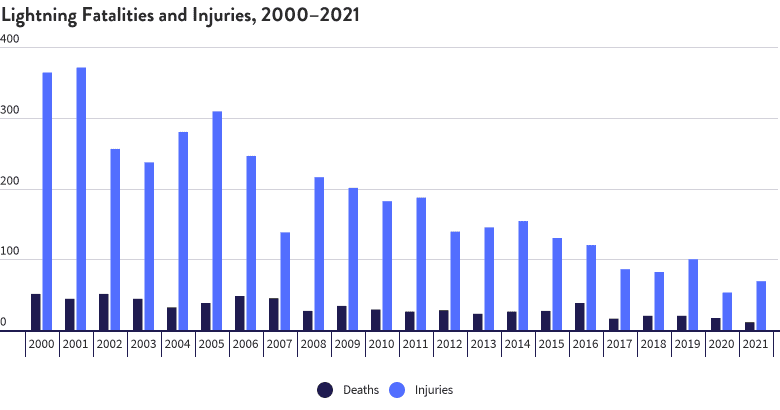Lightning is part of natural and dangerous natural phenomena like thunderstorms, forest fires, volcanic eruptions, snowstorms and other similar events. In this article, we utilize information from the National Weather Service, Insurance Information Institute, National Weather Service and Centers for Disease Control and Prevention to take a look at how lightning strikes in the U.S., how much of a danger they pose and the overall economic impact of lightning strikes per year.
Lightning Strikes in the US: Facts, Trends and Impacts
Lightning is a serious consideration when traveling, buying property, searching for insurance or making home improvements.
 NP
NPNathan Paulus
Director of Content Marketing, MoneyGeek
Nathan Paulus is the Head of Content Marketing at MoneyGeek, with nearly 10 years of experience researching and creating content related to personal finance and financial literacy. Paulus has a bachelor's degree in English from the University of St. Thomas, Houston. He enjoys helping people from all walks of life build stronger financial foundations.
 AS
ASAliha Strange
Freelance Web Content Editor
Aliha believes that knowledge is power. Her desire is to help others who grew up with socioeconomic disadvantages, like herself, learn financial literacy, avoid predatory lending and build toward generational wealth. As a freelance web content editor, she’s empowered to use her creative background and technical strengths to craft informative content. Aliha is a graduate of Seattle Pacific University, where she studied English literature and creative writing. She had the privilege of studying at the University of Salamanca in Spain during her college career, where she developed an appreciation for global perspectives, language and culture. She has over three years of experience as a legal assistant with Davis Wright Tremaine LLP in the Real Estate and Litigation practice groups. In her personal time, she enjoys living in sunny California and serving the homeless community.
 NP
NPNathan Paulus
Director of Content Marketing, MoneyGeek
Nathan Paulus is the Head of Content Marketing at MoneyGeek, with nearly 10 years of experience researching and creating content related to personal finance and financial literacy. Paulus has a bachelor's degree in English from the University of St. Thomas, Houston. He enjoys helping people from all walks of life build stronger financial foundations.
 AS
ASAliha Strange
Freelance Web Content Editor
Aliha believes that knowledge is power. Her desire is to help others who grew up with socioeconomic disadvantages, like herself, learn financial literacy, avoid predatory lending and build toward generational wealth. As a freelance web content editor, she’s empowered to use her creative background and technical strengths to craft informative content. Aliha is a graduate of Seattle Pacific University, where she studied English literature and creative writing. She had the privilege of studying at the University of Salamanca in Spain during her college career, where she developed an appreciation for global perspectives, language and culture. She has over three years of experience as a legal assistant with Davis Wright Tremaine LLP in the Real Estate and Litigation practice groups. In her personal time, she enjoys living in sunny California and serving the homeless community.
Updated: May 22, 2024
Advertising & Editorial Disclosure

Fast Facts on Lightning Strike Statistics
Lightning strikes can cause property damage and, in some cases, loss of life. Here are some key points regarding lightning frequency and damage in the U.S.

Lightning is caused by negative charges from the clouds and positive charges from the ground interacting with each other and generating energy.
Thunderstorms usually follow just a few seconds after lightning strikes.
11 deaths and 69 lightning-related injuries were reported in 2021, making lightning the least destructive weather phenomenon in the U.S.
Some of the most lightning-prone areas in the U.S. are Florida, Texas and California.
Having home insurance to help cover lightning-related damages is wise, especially if you live in an area prone to thunderstorms.
Lightning Fatalities and Injuries by Year
Weather-related deaths have become more common with the onslaught of more powerful storms. This begs the question: Why?
Aside from the known science behind natural disasters, they mostly remain a mystery. However, we can observe a more measurable question: How many people get struck by lightning in a year?

Source: National Weather Service
A summarized report by The National Weather Service covering the 50 states and U.S. territories Guam, Puerto Rico and The Virgin Islands shows that 11 deaths and 69 injuries were associated with lightning strikes in 2021. However, 2000 had the most severe damage, with 51 deaths and 364 injuries. This number has steadily decreased over the years.
These numbers pale compared to other natural disasters like tornadoes, flash floods and rip currents, which incur deaths in the thousands. In summary, lightning strikes are dangerous, but fatalities remain uncommon in the U.S.
Lightning Strike Deaths by Month
Although certain states like Florida, deemed the "lightning capital" of the U.S., experience more lightning strikes than others, consider looking at more holistic data to decipher the likelihood of an individual being struck by lightning each month. Below is a monthly report of lightning fatalities.

Source: National Weather Service
Lightning-related deaths remain relatively uncommon even on a month-per-month basis. According to the chart above, rarely do lightning-related deaths reach double digits. However, when they do, it usually happens during the summer months, when a hotter climate can cause lightning strikes to become even more powerful than they usually are.
Areas more susceptible to thunderstorms also have a higher chance of regular lightning strikes. It pays to monitor how often thunderstorms occur in your area during any given season. Certain outdoor activities like fishing, relaxing at the beach, playing outdoor sports or boating can leave more people vulnerable to lightning strikes, so these activities are best avoided during stormy weather.
The most common time for lightning-related deaths is on weekends, mainly Saturdays and during afternoon hours. Between noon and 6 p.m., two out of three lightning deaths occur.
Lightning Strike Fatalities by State
Although lightning can strike everywhere in the U.S., the Southeastern states are the most vulnerable. Except for a few locations, such as the Rocky Mountains, where thunderstorms frequently occur throughout the summer, the chances of lightning happening typically dips from the southeast to the northwest.
According to the CDC, the states with the most lightning-related deaths and injuries include Florida, Texas, Colorado, North Carolina, Alabama, Arizona, Georgia, Missouri, New Jersey and Pennsylvania. Florida is called the “lightning capital” of the country, with more than 2,000 lightning injuries over the past 50 years.
People who work outside or enjoy outdoor activities are more likely to be struck by lightning. Nearly two-thirds of lightning deaths from 2006 to 2021 were caused by recreational activities like fishing, boating, playing sports and resting at the beach. Men are four times more likely to be victims of lightning strikes than women.
The Cost of Lightning Strikes
Lightning strikes may be one of the least deadly natural disasters, but this doesn't mean that they aren't costly. This is why taking precautions, such as having home insurance or building an emergency fund, is essential.
Year | Value of Claims ($ millions) | Number of Claims | Average Cost Per Claim |
|---|---|---|---|
2017 | $917 | 85,020 | $10,781 |
2018 | $909 | 77,898 | $11,668 |
2019 | $920 | 76,860 | $11,971 |
2020 | $2,067 | 71,551 | $28,885 |
2021 | $1,313 | 60,851 | $21,578 |
Source: Insurance Information Institute
Based on the table above, there are a few key takeaways homeowners should consider when living in a thunderstorm-prone area.
- Despite a consistent decline in lightning-related homeowners insurance claims during a five-year period (2017-2021), the average cost per claim increased by 100% ($10,781 to $21,578).
- Between 2020 and 2021, the number of lightning-related homeowner insurance claims in the U.S. dropped by approximately 15%.
- The number of lightning-related homeowner insurance claims in the U.S. decreased by more than 36% from 2020 ($2.06 billion) to 2021 ($1.31 billion).
- Between 2020 and 2021, the number of lightning-related homeowner insurance claims in the U.S. decreased by 15%. This began with a significant drop in 2017 of more than 28%, from 85,000 to roughly 60,000.
Although deaths may be scarce, recovering and restoring damaged assets can be difficult. It pays to go with an insurance company that does cover lightning-related damage to your property. This is especially true if you live in a thunderstorm-prone area.
States With the Most Lightning Losses by Insurance Claims
The damage from lightning strikes can affect an individual’s mental health, physical health and assets. Review the value of insurance claims below for the top 10 states affected by lightning in 2021.
State | Value of Claims ($ millions) | Number of Claims | Average Cost Per Claim |
|---|---|---|---|
Florida | $88 | 5,339 | $16,552 |
Texas | $95 | 4,490 | $21,206 |
Georgia | $44 | 3,817 | $11,492 |
California | $523 | 3,381 | $154,574 |
New York | $45 | 2,426 | $18,592 |
Pennsylvania | $34 | 2,410 | $14,134 |
North Carolina | $37 | 2,377 | $15,522 |
Louisiana | $28 | 2,372 | $11,817 |
Alabama | $29 | 2,276 | $12,906 |
Michigan | $27 | 1,887 | $14,291 |
Source: Insurance Information Institute
Although Florida has been named the "lightning capital" of the U.S., California residents experienced more structural damage in 2021, with more than $100,000 as the average cost per claim in the state. Texas ranked second at more than $20,000 per claim. Other states amounted to around $11,000 to $18,000 per claim.
According to insurance claims, the top 10 states with the most lightning-related losses in 2021 amounted to $291,086 on average.

Source: Insurance Information Institute
What makes these states more prone to lightning-related damage than other states that didn't make this list? It all boils down to how prone each state is to more frequent thunderstorms. Lightning strikes and thunderstorms are inherently related, and once lightning occurs, thunder usually follows.
As expensive as insurance may be, it's still advisable for homeowners who live in these high-risk states to invest in the proper plan that can compensate them appropriately for lightning damage incurred.
Understanding Lightning Strikes
It's best to understand the different kinds of lightning strikes, where they usually occur, and their threat level. Lightning occurrences are more common than some may think. Staying informed is the best defense against the threat of lightning.

Where Does Lightning Strike?
Because thunderstorms and lightning strikes are related, areas with higher chances of thunderstorms will also have more lightning strikes. The states with the most lightning strikes include Arkansas, Arizona, Mississippi and New Mexico. The most lightning-related deaths have occurred in Texas and Florida.
Once you see lightning, count how many seconds it takes before you hear thunder. You can calculate your distance (in miles) from the flash by dividing the number of seconds by five. Divide by three if you want to know the distance in kilometers.
Different Types of Lightning Strikes
It may come as a surprise, but not all lightning strikes are the same. There are two different types of lightning. It’s beneficial to distinguish which of the two is more dangerous. Although visually alike, here are the two different types of lightning:
Cloud-to-Ground: This type of lightning is common and is likely the kind of lightning you can observe during a regular thunderstorm. Cloud-to-ground (CG) lightning is characterized by a step ladder formation which occurs when positive and negative charges collide, generating a bolt of energy.
Cloud Flashes: Cloud flashes are less dangerous strikes that do not touch the ground but remain in the cloud in which it forms. Unlike CG lightning, it is more of a concern for different kinds of aircraft than it is for people on the ground.
Lightning Strike FAQ
Below are frequently asked questions regarding lightning strikes, thunderstorms and how individuals can protect themselves and their assets.
Not many people in the U.S. experience being struck by lightning. There were 11 deaths and 69 injuries reported in 2021.
Lightning is caused by the attraction of negative charges from the clouds and positive charges from the ground. From this interaction, an extreme discharge of electricity is created.
Yes. Lightning causes thunder, which usually happens within a few seconds of lightning.
If you live in a thunderstorm-prone area during the summer, monitor weather forecasts and stay indoors during thunderstorms.
Yes, if you live in an area with frequent thunderstorms, purchasing insurance that covers lightning strikes is a wise choice to protect your property against damage.
Expert Insights on Lightning Strikes
While lightning strikes are less common than other types of natural calamities, it’s still essential to know how to protect yourself, your loved ones and your property.
- How can homeowners best protect themselves financially against potential lightning strikes?
- How can homeowners upgrade their homes to reduce the likelihood or mitigate the damage of lightning strikes?


Related Content
Learn more about mitigating natural disaster damage through MoneyGeek’s guides.
- Does Homeowners Insurance Cover Lightning Strikes?: Most standard insurance policies include lightning damage, but coverage depends on the damage. MoneyGeek explains when and how homeowners insurance covers lightning strikes in this article.
- Wildfires by the Numbers: Learn about wildfire statistics in the U.S.
- US Catastrophes: Facts, Trends and Impact: Take a look at the numbers behind the natural catastrophes in the U.S. in this MoneyGeek guide.
- Does Homeowners Insurance Cover Natural Disaster Damages?: Learn what home insurance covers regarding natural disaster damages.
- Navigating Climate Change and Insurance as a Homeowner: Climate change can affect how you navigate home insurance.
About Nathan Paulus

Nathan Paulus is the Head of Content Marketing at MoneyGeek, with nearly 10 years of experience researching and creating content related to personal finance and financial literacy.
Paulus has a bachelor's degree in English from the University of St. Thomas, Houston. He enjoys helping people from all walks of life build stronger financial foundations.
sources
- National Severe Storms Laboratory. "Severe Weather 101." Accessed October 25, 2022.
- Centers for Disease Control and Prevention. "Lightning Strike Victim Data." Accessed October 25, 2022.
- National Weather Service. "Summary Of Natural Hazard Statistics For 2021 In The United States." Accessed October 24, 2022.
- National Weather Service. "Lightning Fatalities 2021 By State." Accessed October 24, 2022.
- Insurance Information Institute. "Facts + Statistics: Lightning." Accessed October 24, 2022.
- National Library of Medicine. "Lightning Injuries." Accessed October 24, 2022.











